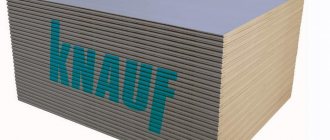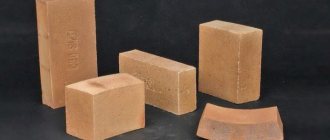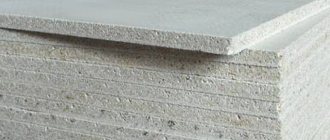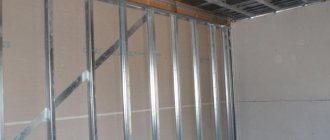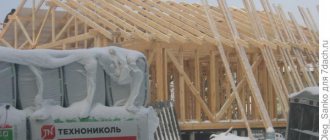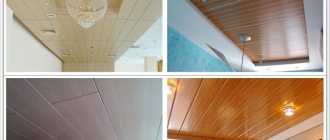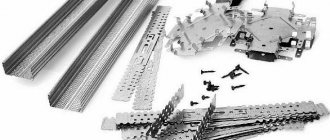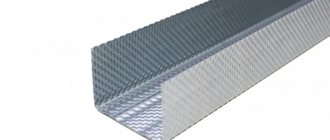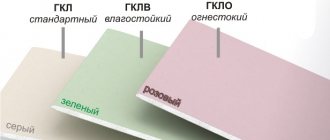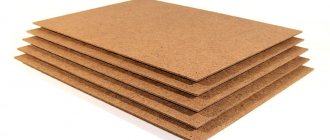At the stage of building a house or during renovation work, materials for “dry” installation are selected. This simplifies the process, increases the speed of its implementation, and allows you to get an excellent result by performing fewer operations. Material costs with this finishing method are also reduced. We are talking about gypsum-based sheets: gypsum board, gypsum board. They have similarities, but also a number of differences, which often do not allow the products to be used in one place. To increase the service life of the finished structure, you should choose the type of gypsum-based sheets, taking into account the correspondence of the properties to the operating conditions.
Gypsum fiber sheet. Definition
Gypsum fiber sheets are a mixture obtained by pressing gypsum with a layer of paper. This method is dry, that is, without the use of moisture. Unlike drywall, gypsum fiber consists of 2 layers, but the second layer is primed. They are very similar in appearance. Gypsum fiber is widely used nowadays. It is used for finishing rooms, sanitary facilities, kitchens, bathrooms, rooms that have high fire safety requirements, and so on. All this makes it indispensable today.
Structure of gypsum fiber sheet.
Due to the fact that it has increased strength due to its structure, it can be used for the construction of load-bearing surfaces, as well as suspended ceilings. The latter is the most relevant. Gypsum fiber can be of different types; it must be selected strictly individually for each room. Like drywall, gypsum fiber has a number of valuable and useful properties, but it also has distinctive features. Let's take a closer look at the main ones.
What is gypsum board?
GKL is an abbreviation for the name Gypsum Cardboard Sheet. This material consists of two cardboard sheets, between which there is a layer of gypsum. They are connected to each other using construction adhesive.
It is often called “plasterboard”, or the abbreviation gypsum board is used, sometimes you can hear “gypsum board”. The latter name is found zonally - more common in St. Petersburg and its environs.
In this region, drywall was supplied by Finnish), which gradually became a household name.
GCR is used for “dry” leveling of walls or cladding of frames in frame housing construction. Suitable for interior use, too fragile for exterior use. Drywall is used for walls, partitions, and ceilings.
In the production of gypsum boards, thick and smooth cardboard is used. It serves as a reinforcing and shaping element. The gypsum layer gives strength and keeps its shape.
In most cases, a sheet of drywall has a thinner edge on the long side (there are also even ones with right angles).
This allows you to carefully putty the joints when joining. So for some types of finishing materials it is not necessary to putty the entire area.
Drywall is produced for different operating conditions; for easy recognition, cardboard of different colors (gray, green, pink) is used:
- For premises with normal operating conditions - standard plasterboard. Has a gray color.
- For rooms with high humidity levels - moisture-resistant gypsum plasterboard. It turns green.
- For fire hazardous premises/buildings - fire resistant - GKLO. Has a pink color.
- In rooms with increased fire hazard and high humidity, GKLVO is used - fireproof, moisture-resistant plasterboard.
- Recently, soundproofing plasterboard (GKLZ) has become popular. It has a high-density gypsum core and is reinforced with fiberglass. Designed to increase sound insulation of frame-sheathing structures of walls, ceilings and partitions. The leaf is purple or blue in color.
Now you know what gypsum plasterboard is, what types of drywall there are and where they are used. This is a popular material for interior decoration.
It does not contain harmful substances, although gypsum dust that may appear during operation may pose some danger. To decide which is better GVL or GVK, now let's talk about gypsum fiber.
GVL and gypsum plasterboard: what is it in construction
Drywall and gypsum fiber are relatively new building materials. They appeared a couple of decades ago, but have already confidently supplanted traditional materials. To understand the best way to use GVL or gypsum board, you need to have a clear idea of what kind of materials they are, what their advantages and disadvantages are. Based on this knowledge, you will be able to make the best decisions yourself. Because it is impossible to say unequivocally which is better - GVL or gypsum board. In some places one material is more suitable, in others it is better to use a second one. So let's figure out what these materials are and what types of gypsum board and gypsum fiber board exist.
GCR: what is it and what types are there?
GKL is an abbreviation for the name Gypsum Cardboard Sheet. This material consists of two cardboard sheets, between which there is a layer of gypsum. They are connected to each other using construction adhesive. It is often called “plasterboard”, or the abbreviation gypsum board is used, sometimes you can hear “gypsum board”. The latter name is found zonally - more common in St. Petersburg and its environs. In this region, drywall was supplied by Finnish), which gradually became a household name.
GCR is used for “dry” leveling of walls or cladding of frames in frame housing construction. Suitable for interior use, too fragile for exterior use. Drywall is used for walls, partitions, and ceilings.
In the production of gypsum boards, thick and smooth cardboard is used. It serves as a reinforcing and shaping element. The gypsum layer gives strength and keeps its shape. In most cases, a sheet of drywall has a thinner edge on the long side (there are also even ones with right angles). This allows you to carefully putty the joints when joining. So for some types of finishing materials it is not necessary to putty the entire area.
GKL can have different edges. You need to choose it depending on the area of use
Drywall is produced for different operating conditions; for easy recognition, cardboard of different colors (gray, green, pink) is used:
- For premises with normal operating conditions - standard plasterboard. Has a gray color.
- For rooms with high humidity levels - moisture-resistant gypsum plasterboard. It turns green.
- For fire hazardous premises/buildings - fire resistant - GKLO. Has a pink color.
- In rooms with increased fire hazard and high humidity, GKLVO is used - fireproof, moisture-resistant plasterboard.
- Recently, soundproofing plasterboard (GKLZ) has become popular. It has a high-density gypsum core and is reinforced with fiberglass. Designed to increase sound insulation of frame-sheathing structures of walls, ceilings and partitions. The leaf is purple or blue in color.
GKLZ - soundproofing plasterboard. KNAUF sheet (GSP-DFH3IR) has the following properties: increased density, moisture resistance, impact resistance, increased strength
Now you know what gypsum plasterboard is, what types of drywall there are and where they are used. This is a popular material for interior decoration. It does not contain harmful substances, although gypsum dust that may appear during operation may pose some danger. To decide which is better GVL or GVK, now let's talk about gypsum fiber.
GVL - what is it, what is it made from, what types are there
The name GVL is also an abbreviation from the technical name of the sheet building material: Gypsum Fiber Sheet. This material is made from a mixture of gypsum with cellulose fibers (fluffed waste paper). The mass is mixed with water, sheets are formed from it under a press, which are brought to normal humidity (dried).
Types of edges - for walls it is better with a chamfer, for floors - even
GVL is also used for dry leveling of walls and ceilings, cladding frames, and flooring. Unlike gypsum board, it has “basic” non-flammability, since cellulose is covered with a layer of non-combustible material - gypsum. GVL is produced with two types of edges - flat and folded. The seam edge is removed with a plane, the chamfer depth is about 2 mm, the width is about 30 mm. When installing on walls, this allows you to further strengthen the seam (lay a reinforcing mesh) and putty it.
Gypsum fiber boards acquire special properties with the help of special additives. Based on this feature, there are the following types:
- Standard - GVL. For installation in rooms with normal humidity.
- Moisture resistant - GVLV. Used in rooms with high humidity levels to level the floor without screed.
- High-strength, moisture-resistant material for flooring. It is marked with GVLV EP (moisture-resistant GVL Floor Element).
General information
The width, length and thickness of the material are specified in GOST. The nominal lengths will be 1.5, 2, 2.5, 2.7 and 3 meters, and the width of the sheets will be ½, 1 and 1.2 meters. Permissible deviations will be 0.4 cm, 0.5 cm in width, and approximately 0.03 cm in thickness. The sheet shape is a rectangle. The most popular sheets are 2.5 and 3 meters, and the width of the material used is 1.2 meters, and the thickness is 0.95 and 1.25 cm.
Materials for gypsum boards
The company uses gypsum as the main panel element. The gypsum binder used in construction is made from natural stone and obtained artificially. Gypsum stones are subjected to temperature treatment, and products made from gypsum binder are pure construction material. In order to achieve performance, components are added to the gypsum, and this will also improve its quality.
Characteristics and properties of materials
Drywall must withstand minimum permissible loads, and the main supplier of plasterboard sheets will be the Knauf company, and the sheets can withstand a load of 730 N. The mass of each sheet is 29 kg, and the fire resistance of plasterboard will be 1/3 hour. A company like Knauf developed fire protection products for interior decoration. Knauf FIRELINE was able to release a line of materials that can include:
- Coated sheets.
- Panels that are not treated.
The material has acoustic properties such as absorption, reflection and vibration. Fire-resistant products have the following components - decorative surface (varnish, veneer or laminate), drywall and substructure.
Differences between GKL and GVL
We suggest that you first consider a simple gypsum board, what it is, and how it differs from gypsum plasterboard. Drywall is made from gypsum with special additives and a cardboard finish. Depending on the area of use, the material has different qualities and composition. For visual distinction, products must be painted and labeled. There are such types of drywall:
- GKLVO.
- GKLO.
- GKLV.
- GKL.
The last option can be ceiling or wall. GKLO is a fire-resistant material, and it also contains reinforcing additives. The sheets are used exclusively in dry rooms, and the marking color for such cardboard is red. GKVL is a moisture-resistant material that is fully impregnated with antibacterial and hydrophobic compounds, and water-repellent compounds are added to the gypsum layer, and therefore it is used indoors with a high level of humidity. The cardboard is green and the markings will be blue. GKLVO sheets are resistant to fire and moisture, and the product combines the properties of GKLV and GKLO, adding hydrophobic components. GVL can have a high density - 1240 kg per cubic meter. The panels are made from reinforced cellulose, gypsum and special additives. GVL from Knauf differs from plasterboard sheets - it creates a healthy microclimate, absorbs excess moisture, is frost-resistant and durable.
When is it possible to use?
The material is used during construction work in rooms with normal and low humidity levels. You can even use it in attic renovations, but only if there is sufficient air circulation. In the kitchen, bathrooms and other rooms with high humidity, moisture-resistant building material - GVLV - is used.
The material is frost-resistant, which makes it possible to decorate unheated premises, for example, garages, sheds and other outbuildings. For wooden buildings, the use of gypsum fiber board provides fire protection.
Like any building material, this one also has its advantages and disadvantages.
Positive characteristics:
- Since gypsum fiber sheet contains only gypsum and paper, it is an environmentally friendly material. When working with it, no toxic substances are released, and there is no risk of respiratory diseases when sawing sheets. It does not contain synthetic resins or polymer inclusions; it can be safely used for interior decoration of residential premises.
- Resistant to temperature changes, so can be used in unheated rooms.
- Has high noise insulation characteristics. Can suppress noise of 30-45 dB.
- GVL tolerates moisture well. Therefore, it is used in finishing kitchens and bathrooms.
- High fire resistance makes it possible to sheathe wooden floors, beams, and walls.
- It has low thermal conductivity and is used for wall insulation.
- The high viscosity of the material allows nails to be driven into it and screws to be screwed in, and they will be securely fastened inside the sheet. This factor also influences the fact that gypsum fiber board practically does not crack and does not become painted. It can be easily cut to size using the same tools as drywall and plywood.
- Lightweight, so inexpensive profiles and frames can be used for installation.
- The material is easy to process, with minimal waste during installation.
- Thanks to the use of cellulose fiber, the sheet is more flexible than gypsum board. Its bending strength ranges from 5 to 6 MPa, which is significantly higher than plasterboard. Therefore, it is easier to make complex decorative structures from gypsum plasterboard - arches, curved surfaces.
- Gypsum fiber sheet can withstand up to 20 freezing cycles without loss of characteristics, which makes it possible to use it for finishing periodically heated or unheated rooms.
Despite the huge number of advantages, the use of GVL also has some disadvantages:
- heavy weight, one plate – about 18 kg;
- the price of gypsum board is higher than that of drywall;
- absorbs moisture well, this limits the use of the material or requires treatment with special water-repellent substances.
There is a large selection of products on the market. Typically, the best manufacturer is considered to be the brand that first produced the product. At the moment, Knauf is considered the best in all of Europe, although it is the most expensive. There are also products from domestic manufacturers on the market, but the technical characteristics of the material may be slightly worse.
For walls
Gypsum fiber sheets are used for walls to level the surface, for sound insulation and thermal insulation.
This material can be mounted in two ways: frameless and using a frame. The frameless method is used if the unevenness of the walls is not too large. Special gypsum glue is applied and pressed against the wall. With this method, it is better to take sheets of small parameters.
If the unevenness of the walls is large, up to 3-4 cm, the sheets are glued with a special glue, applied along the perimeter and in the center, every 30 cm. If you plan to hang any shelves and cabinets on the wall, then the entire surface of the sheet is smeared with glue. Before installation, the material is brought into the room 2-3 days in advance so that it adapts to the temperature and humidity conditions.
With the frame method, the gypsum plasterboard is attached using self-tapping screws with double-row threads to a frame made of durable galvanized profiles. You can put material inside for insulation and sound insulation. Profiles must be selected so that they can withstand heavy weight. Installation is carried out from the bottom up, starting from the corner of the room.
For floor
Mark the floor level. Lay a vapor barrier. The use of GVL makes it possible to use so-called heated floors. Expanded clay is poured onto the prepared surface and leveled. The sheets are coated with glue and fastened with self-tapping screws. The joints are puttied.
You can lay laminate or tile on this floor.
Such a wonderful material as gypsum fiber sheet is widely used in construction and repair work. This is a reliable building material for interior decoration. It justifies its high cost, which is higher than conventional plasterboard sheets, with a number of characteristic advantages.
Details
Moisture-resistant GVLV and GVL
Moisture-resistant GVL for flooring can be used in a room with a humidity of 60%. GVL is a dense material made from fluff cellulose fibers and gypsum. GVL panels are low-flammable materials of class G1, and the products are used in fire-resistant structures. Panels can have straight (PC) and folded (FC) edges. GVLV can be used in unheated rooms, and the panels are treated with a water repellent. GVLV materials can weigh from 32 to 44 kg, and the main parameters of the sheets are:
- Hardness more than 20 MPa.
- Low thermal conductivity.
- Vapor permeability.
- Humidity less than 1%.
- The bending strength limit is from 5.5 to 5 MPa.
The use of gypsum fiber panels makes it possible to reduce finishing work, and GVLV and GVL Knauf slabs insulate floors, room walls, verandas, attics and attics. Among the advantages of the material are:
- Does not emit harmful substances.
- Water resistant.
- The panels are extremely reliable (able to withstand heavy objects).
- Fire resistance and sound insulation.
In order to understand as best as possible what GVL is, it is also important to know about the panel manufacturing process. You should watch the video for a clear overview of plasterboard production.
Sheet creation process
Drywall is made using injection molding technology, and a cardboard strip will go along the conveyor, onto which a binding liquid substance is poured. From above, everything is rolled into a cardboard sheet and rolled out. After this, when the binder has set, the material is cut to size on a guillotine, and then the product is sent for drying. Gypsum fiber materials are made by semi-dry pressing. A 5-7 cm layer of a binder containing cellulose is poured onto the molding table. All this will be pressed to a thickness of 1.2 cm, and after the press you will get a hard surface that will dry. The processes for creating drywall and fiberboard are very different. Moreover, the materials are finished differently. Drywall can be puttyed immediately, but gypsum plasterboard does not have a perfectly smooth surface, and for this reason finishing and base putty are applied. It is not difficult to figure out from the GVLV marking that such a material is resistant to moisture. Here are some examples of markings: GVLV-PK-2.5*1.2*0.1 meter, or GVL-FK-2.5*1.2*0.1 meter.
Working features with moisture-resistant drywall
GVL is ideal for work indoors where the environment is aggressive:
Swimming pools.- Showers.
- Bathrooms.
- Kitchens.
The edges and joints of the panels are treated with moisture-proof specialized solutions. Impregnation is carried out before finishing work so that moisture does not get inside the material. Installation work begins with making a frame, for which metal profiles are used. We suggest considering gypsum fiber sheets for the kitchen and bathroom, and Knauf offers decorative and design options that are specially designed for wet use. Complete Knauf Dry Construction systems for interior finishing are recognized as advanced.
Frame
Installation of gypsum fiber boards can be done in two main ways - frame and frameless. In the first case, a frame is pre-constructed onto which the slabs are subsequently fixed. In the second, the slabs are glued directly to the wall surface using special glue.
The best material for creating a frame for false walls is a metal profile.
Work is carried out in the following sequence:
- Marking the room - using special tools, marks are made on the surface along which the frame will be mounted in the future.
- Installation of the starting profile involves mounting a frame around the perimeter of the room. For this purpose, anchors with sleeves made of plastic or metal are used. They are screwed into pre-drilled holes with a depth of 40 mm. In areas where the profile adjoins the main structures, a sealant is applied.
- Installation of the post opening begins with the doorway, its edges are mounted from two-post elements built exactly into each other. All necessary parts must be fixed with wooden blocks. The jumper is made from a profile for racks, bent in a U-shape.
- Formation of vertical posts - they are inserted into the starting profile from above and below, the pitch is calculated so that the edges of the gypsum fiber board fall exactly on the center of the guide when sheathing. The main thing is that the gypsum fiber sheets are placed on both sides of the partition being formed with a slight offset of the joints.
When installing the frame, do not forget to think about communications; for this purpose, special holes are made in the racks for cables and electrical wires.
Covering a frame with panels is a rather labor-intensive job that requires effort and time:
- The gypsum plasterboard sheet is cut so that when joining the slabs there is a gap of at least 5 mm. If this rule is not followed, deformations may occur in the future.
- The trimmed sheet of gypsum fiber is applied to the frame and leveled. If its edge “sags,” an additional metal jumper is inserted into the structure.
- The plate is fixed using self-tapping screws; screws should be 4 cm long and tightened in increments of 30 cm.
The structure of gypsum fiber is porous, this often causes uneven application of paint or glue during further finishing of the gypsum fiber surface. That is why you should carefully putty the surfaces of the entire area of the slabs. To do this, you can use the most common gypsum putty. Only after this the wall becomes suitable for any type of finishing materials.
How much does GVL cost: overview of the main sizes and types
The price of gypsum fiber boards for flooring primarily depends on the type and size of products, which can be different. The German company, founded in the middle of the last century, has been considered the leader on the market for many years. It was she who first began producing gypsum-based building materials.
The most popular when designing floor coverings are moisture-resistant gypsum fiber boards for Knauf-superfloor floors, which are characterized by increased thickness and improved strength characteristics. The average cost of gypsum plasterboard for flooring is 250-350 rubles.
On average, one sheet of gypsum fiber board for the floor can be purchased for 250-350 rubles.
The most common and most popular slabs are the following sizes:
- GVL for floors, moisture-resistant 1200x600x10mm - price 180 rubles;
- GVLV PC 2500x1200x12.5 mm – 590 rub.;
- GVLV FC 2500x1200x12.5 mm – 610 rub.;
- GVLV FC 2500x1200x10 mm – 520 rub.;
- GVL for floors, moisture-resistant 1200x600x20mm Knauf-superfloor - 275-325 rubles;
- fireproof gypsum board Fireboard Knauf 2500x1200x12.5 mm – 2290 rub.
Of course, besides, there are other manufacturers. For example, it is considered one of the most popular in the world and also produces gypsum-based products, but its product range includes only plasterboard. Thus, a slab from this manufacturer with a size of 2500x1200x12.5 costs exactly 2 times cheaper than moisture-resistant gypsum fiber boards for floors 1200x600x20mm from Knauf, because the price, depending on the type of material, is 210-310 rubles. It should be remembered that using gypsum plaster boards for the base is strictly not recommended.
Frame installation of GVL
The frame is made of wooden slats made of material with a cross-section of no less than 3.0 x 5.0 cm. The transverse size of the vertical posts is 2.5 x 7.5 cm. The fastening spacing does not exceed the width of the gypsum board, recommended - 40 cm. The gypsum board is mounted on self-tapping screws with a length of at least 30 mm in increments of 25 cm (with a slab width of 1.2 m). Glass wool is used for insulation.
The slabs are installed starting from the middle of the wall. A small gap is left between them, about 5-7 mm.
The metal frame is much more reliable. It is made from galvanized guides and load-bearing wall and ceiling profiles with a thickness of 0.56-0.6 mm, and installation is similar to lathing under plasterboard sheets.
Assembly is carried out as follows:
- The surface is being prepared. The old coating is removed. True, not all masters advise this, considering it an unnecessary waste of time and effort.
- Using a level, plumb line and pencil, mark the wall. For vertical racks take a ceiling profile. The guides are mounted in areas adjacent to the floor and ceiling.
Frame method
- The brackets are attached to the racks with self-tapping screws, and the profiles are aligned using a folding cutter. The profiles are attached to the ceiling with dowels in increments of 60 cm or slightly less.
- GVL are installed from bottom to top or top to bottom with a small gap between them.
Laying on the floor
Before laying GVLV sheets on the floor, the base must be carefully prepared. It is necessary to eliminate all surface irregularities and errors. This can be done using cement mortar or polyurethane foam.
The old floor covering should be removed and the surface should be cleared of debris. Next, a layer of waterproofing is laid, and if necessary, a layer of expanded clay is poured.
You can install the sheets as follows:
First, the damper tape is glued. Then you should start laying the sheets themselves. You can secure them to the floor using special screws or glue. The recommended distance when screwing in self-tapping screws is about 35-40 cm apart
It is important to know that each new row should be laid with a seam shift. It must be at least 20 cm. During the final work, you should begin processing all joints between the slabs
Sometimes the same glue is used for this, but sometimes putty is also used. After the leveling compounds have dried, the main coating can already be laid on the gypsum fiber.
What are gypsum fiber sheets: key characteristics
In appearance, gypsum fiber sheets are very similar to plasterboard, but their production technology is completely different. In both cases, gypsum is used for manufacturing, but if cardboard is used for gypsum board, then the key component in gypsum board is cellulose fiber, which is obtained by processing waste paper. In addition, gypsum plasterboard sheets are homogeneous, while drywall consists of several separate layers.
To produce GVL, cellulose fiber and gypsum are used. Please note! When choosing between gypsum plasterboard or plasterboard, you need to take into account that gypsum plasterboard is not used for flooring due to its fragility and insufficient strength.
The production of gypsum fiber (gypsum fiber) boards is regulated by the requirements of GOST R 51829-2001, so the use of the material is clearly regulated. According to the standards, panels can be used in private, public and industrial premises, including children's institutions. In addition to flooring, the sheets are suitable for cladding walls and ceilings. The material is perfect for pre-finishing, thus eliminating the need for plaster, putty and the use of liquid screed.
The composition of the sheets, in addition to gypsum and loose cellulose fiber, also includes latex, which not only gives the material strength, but also gives the panels moisture-resistant qualities. During production, all components are mixed together, after which the finished mixture is gradually diluted with water. The resulting dough-like mass is then fed to the press, where the finished slabs are formed. After pressing, the panels are dried. Some then go through a sanding process, while others remain as is.
Drywall: price per sheet, sizes, types of material (read more)
As a rule, treated slabs are more expensive and are used mainly for finishing floors and walls. GVL floor panels are not sanded, because a finishing coating is then laid on top of them - this can be tiles, laminate, parquet or even linoleum and carpet. The sheets can be mounted on joists or on a subfloor, on which all cracks and cracks are previously sealed. They can also be used in the case of a floating floor, as a material for dry screed, which does not require a long time to dry. Moreover, the material is considered suitable even for surfaces on which it is planned to subsequently exert significant loads.
GVL sheets are used not only for floors, but also for cladding ceilings and walls.
For the purpose of additional leveling, it is permissible to attach gypsum fiber boards to a wooden floor, concrete or cement base
It is important that the sheets not only level the surfaces, but also allow you to soundproof and insulate the floor. At the same time, the material has “breathable” properties, which allows it to let air through.
This quality helps to establish the microclimate in the room. A GVL floor is capable of absorbing excess moisture that is released from the environment.
Scope of application of gypsum fiber
Knauf gypsum fiber sheets are successfully used for finishing walls in residential premises, as well as for the construction and finishing of public and industrial buildings. Gypsum fiber is used for the construction of interior partitions and walls in apartments; it is possible to use a waterproof type of gypsum fiber board in rooms with high humidity, such as a bathroom, followed by tiling.
Sheathing of frame structures, such as partitions, wall cladding, suspended ceilings, involves the use of gypsum fiber board with a seam edge.
As a separate area of application, we can mention the use of GVL for the construction of a rough floor covering - dry floor screed using Knauf technology. To create such a floor, so-called Knauf supersheets are used, which have a straight longitudinal edge.
Due to its high fire resistance, it is possible to use GVL for fire protection of load-bearing structures, wooden elements, and cable ducts. The environmental friendliness of the material allows it to be used for finishing the ceiling, floor and walls in any living room, including the bedroom and children's room.
GVL or gypsum board: which is better?
Both materials have admirers and opponents. You will have to decide on your own which is better GVL or gypsum board. In this section we will try to compare them according to the most significant parameters. Let's go over the sizes right away. Drywall is produced in a wider range of both sheet sizes and thickness:
- GKL sheet thickness: 6.5 mm, 8 mm, 10 mm, 12.5 mm, 14 mm, 16 mm, 18 mm, 24 mm. The last three are very rare.
- The height of the gypsum board sheet can be from 2000 mm to 4000 mm in increments of 50 mm.
- The width of the gypsum board is 600 mm or 1200 mm.
As you can see, the range is more than wide. Another thing is that there are usually two or three types on sale. But, if you really want to, everything can be found/ordered. Although, it is usually easier (and cheaper) to buy what is available.
GVL is better for the floor
We had less luck with the size of the GVL. We have only two options for gypsum fiber boards: 2500*1200 mm (standard) and 1500*1000 mm (small format). Both options are available in 10mm and 12.5mm thicknesses. All. There are no other standard sizes. There is also GVL for the floor. Its dimensions are 1200*600 mm, thickness 20 mm. It may be chamfered or not.
| GKL | GVL | |
| Cost per square | from 70 rub/sq.m. | from 180 rub/sq. m. |
| Shock loads | crumbles | tolerates it well |
| Bending loads | tolerates well, bends | breaks down |
| Uncover | easy to cut with a utility knife | you need a serious tool with a special disk |
| Installation of fasteners | special screws are easy to tighten | difficult to twist, you need to pre-drill holes or use self-tapping screws |
| Changes in size with increasing humidity/temperature | 1 mm per meter | 0.3 mm per 1 meter |
| Fire resistance | high - G1 | non-flammable - NG |
| Installation on curved surfaces | available | No |
As a result, it is possible to say that gypsum fiber board or gypsum board is better only based specifically on the area of application and operating conditions. In short, here's how you can divide the areas of application:
- GVL for walls and ceilings is better if fire resistance is required or if it is necessary to increase the rigidity of the structure (in frames).
- It is better to put GVL on the floor, since it reacts less to humidity and does not change its properties.
- GCR is indispensable if you need smooth lines or complex multi-tiered structures. A multi-level ceiling, arches, columns, rounded walls and corners are just drywall.
- If you need to achieve good sound insulation of the second floor, it is better to hem the ceiling with gypsum fiber board.
As you understand, there is no way to definitively say which is better than GVL or gypsum board. In some conditions, one material is better for performing one task, while the characteristics of another are more suitable for another.
Application
The technical characteristics of GVL allow their use in a wide range of construction and finishing works. The most common application is cladding walls, ceilings, door and window openings, both for the purpose of leveling and hiding communications, and for fire protection.
Gypsum fiber sheets can also be used to create internal partitions, since their increased strength allows them to support the weight of doors and other hanging elements. GVL can also be used as a substrate for flooring for reinforced concrete and wooden floors, although in this case it is better to prefer moisture-resistant sheets. Any material can be laid on top: linoleum, laminate, parquet, tile. The use of GVL significantly speeds up flooring compared to “wet” methods, because there is no need to wait for complete drying for several weeks, and compared to OSB, which is often used for the same purposes, GVL does not contain harmful resins and formaldehydes.
An excellent analogue to drywall
GVL plate for finishing
GVL slabs are made from gypsum, and they obtain their strength and properties thanks to a variety of reinforcing additives and cellulose. I must say that you can easily distinguish a gypsum fiber sheet from a gypsum board, since it is homogeneous and does not have a cardboard shell. GVL boards are used for finishing in dry rooms, but there is also a moisture-resistant gypsum fiber sheet and its abbreviation - GVLV. With the help of this material, work at home can be done independently, because the technology for installing slabs does not have any special nuances.
Let's take a closer look at the performance properties of the slab for dry and wet rooms:
- GVL slabs are a fairly hard and durable material, which is also fireproof. Used in rooms and areas with moderate humidity levels. The plate has dimensions 2500*1200, thickness can be 10 mm and 12.5 mm
- GVLV board is a moisture-resistant material that is used in bathrooms and kitchens, as well as in places with high humidity. These slabs can be used to decorate garages and attic spaces. It has standard dimensions 2500*1200, but can also be produced with dimensions 1200*1200 and a thickness of 10 mm
Installation of GVL slab
Among all the properties and advantages of the material, I highlighted the following features:
- GVL sheets are very durable, they are safe and do not burn
- Unlike gypsum plasterboard, gypsum fiber material is more resistant to moisture
- Using slabs you can finish not only walls and ceilings, but also floors with inclined surfaces
- Carrying out work inside the house allows you to quickly and without unnecessary dirt level the walls. In wooden houses, this method is environmentally friendly and the most comfortable for a “breathing” building
- Various communications can be hidden under the slabs
- Due to its strength indicators, during finishing work, screws can be screwed into the gypsum fiber material and nails can be driven in, after which they will stick like wood. Unfortunately, gypsum plasterboards do not have such advantages
- The material is easy to saw or file, so you don’t have to worry about snags when doing DIY work
- Due to temperature changes, the sheets do not deform because they have a low expansion coefficient
- Fire-resistant material that has good sound insulation properties
Gypsum fiber and plasterboard sheets
The name of the sheets is associated with the materials from which they are made. Gypsum fiber gypsum board is a homogeneous, flat sheet containing gypsum reinforced with cellulose fiber. There are the following varieties: standard, which is used in rooms with low humidity, waterproof - for rooms with high humidity.
Gypsum fiber plasterboard is a homogeneous sheet, there are two types: regular and moisture resistant.
GKL - what is it: the decoding of this abbreviation means plasterboard sheet. This material consists of two layers: the middle is made of gypsum, the outer parts are made of cardboard. There are the following types:
- fire-resistant (GKLO) – coated with a fire-resistant composition;
- moisture-resistant (GKLV) – containing a substance that resists mold, fungi, and bacteria;
- combined (KGP PS) - with polystyrene foam composition for insulation, can be used for internal and external work;
- decorative – exclusive, requires careful installation.
What is the main difference
Despite the gypsum base, the materials have many differences:
- drywall is a three-layer sandwich made of paper and gypsum, GVL is a single piece of hardened gypsum mortar;
- The strength of gypsum fiber is many times higher. You can hang kitchen cabinets on it, which is excluded with gypsum board;
- GVL is less natural - it contains magnesium oxide and magnesium chloride. But these components of the composition are harmless;
- drywall has a much smaller scope of application;
- When cut with a knife, gypsum plasterboard crumbles and becomes dusty when working with a grinder; gypsum board is cut without residue;
- breaks differently when cut: drywall down, gypsum fiber upward. A small thing, but important. If you don’t follow the technology, you won’t get smooth edges;
- It is difficult to work alone with GVL due to its heavy weight. Need an assistant;
- The drywall is puttied before wallpapering. For GVL, such an operation is unnecessary. Here only the joints and heads of hardware are sealed;
- gypsum fiber sheets are more difficult to bend. Therefore, they are difficult to use for curved surfaces;
- Heavy gypsum fiber boards must be mounted on a more durable sheathing. Therefore, it is necessary to use a metal profile with a thickness of at least 0.5 mm.
The cost of gypsum plasterboard and its disadvantages
The big advantage over other building materials is that it is inexpensive. Minimum price for 1 sq. m is from 100 rubles. It all depends on the type of plasterboard sheet. If it contains various additives, it will cost much more. The biggest disadvantage is that it is not able to withstand heavy loads, so it should not be used in the construction of load-bearing walls. In addition, many types of gypsum plasterboard are not capable of retaining moisture, so the material is selected individually for each room
This is very important, because otherwise you can simply waste your money. The disadvantage is that drywall is not recommended for use in the construction of load-bearing surfaces, since it is not so durable
https://youtube.com/watch?v=tCsAQtdvTsg
Thus, we can conclude that. that this material is very valuable and is widely used in construction and finishing works. In addition to it, there are other materials, for example, gypsum fiber (GVL). Many will wonder what is better to use: gypsum board or gypsum board. The answer is not simple. Let's take a closer look at what a gypsum fiber sheet is.
Exterior finishing with moisture-resistant boards
GVL for finishing
Due to their performance, the use of slabs is possible even for exterior finishing. The fact is that due to its resistance to temperature changes, it is often used for cladding an unheated room, such as a garage or warehouse.
I must say that for external processes its cost is completely justified, because a small number of building elements can withstand frost and extreme heat. Even mines and boiler rooms are finished with such gypsum fiber boards - in the presence of an open fire, the material not only does not burn, but can also restrain the spread of the flame for some time. The property of fire resistance becomes important for some outdoor works.
From my experience, I want to say that in some cases the use of slabs indoors becomes irrelevant due to its cost, or rather the cost of further finishing. For the floor, it must be primed at least twice, and then also puttied, because it does not have bevels typical of plasterboard slabs. The only way you can save money is if you do all the work yourself and without the involvement of qualified specialists. And even here, the excellent quality and properties of gypsum fiber boards allow you to spend a little more than planned on finishing.
Popular posts
- Chair for dressing table Chairs for dressing tables in Moscow - 189 Products Company from Moscow, delivery 29643 a In…
- Silicone sanitary sealant Silicone sanitary sealant white in Moscow - 1491 products Company from Moscow, delivery (tomorrow) 140...
- Shelf in the hallway Currently, there are a huge number of different options for shelves in the hallway, and this is directly ...
- Insulation of the floor in a wooden Insulation of the floor in a wooden house from below: materials and installation technology SHARE ON SOCIAL NETWORKS One of the common…
Main characteristics of moisture-resistant gypsum fiber sheet (gvlv)
The very concept of “plasterboard” is quite broad, since it includes several types of this material. They differ significantly in operating conditions, and, accordingly, in their composition. In addition, there is such a thing as a “fiber supersheet”. Such material has a number of advantages compared to gypsum board and, according to the Knauf classification, is divided into:
- superlist (gvl),
- moisture-resistant supersheet (gvlv),
- small format supersheet.
Each of the above options is characterized by increased mechanical strength, excellent sound insulation, fire resistance and has a special fibrous structure. The latter property allows you to carefully cut drywall and process edges without much effort.
Technical characteristics of gvl (gvlv)
Gypsum plasterboard supersheet has special properties that allow it to be used not only for covering walls, ceilings, but also for floors! Thanks to a high-quality mixture of fiber and gypsum, as well as a special anti-chalking impregnation, supersheet can be used in buildings and premises for any purpose. The only fundamental difference in the use of gypsum board and moisture-resistant gypsum board is the possibility of installing the latter in places with high humidity. All main parameters of the sheets are given in Table 1.
Table 1. Characteristics of gvl supersheet (gvlv)
The moisture-resistant material differs from standard gypsum plasterboard in that its surface on both sides is treated with a special water-repellent agent. This allows it to be used in rooms with any degree of humidity.
If we talk about the properties of the materials, they are very similar. The dimensions and weight of moisture-resistant gypsum board are the same as those of a standard super sheet. The following characteristics are also identical: humidity, Brinell hardness, flexural strength and thermal conductivity gvl and gvlv. At the same time, the range of applications for moisture-resistant drywall is wider than standard, since even in the bathroom it will “stand idle” for its entire service life.
Advantages and application of moisture-resistant supersheet
Fibrous gypsum board has all the advantages of conventional drywall:
- environmental friendliness,
- high heat and sound insulation,
- non-flammability,
- mechanical strength and abrasion resistance,
- ease of installation.
It has only two drawbacks: price and significant weight of the gvl (gvlv) sheet. The first problem can be solved by minimizing waste, and the second can be solved by using a good assistant during the installation process.
Moisture-resistant plasterboard can be used in almost any type of building. Main use cases:
- in places with a high fire hazard as wall and ceiling cladding,
- for cladding attics, balconies and basements (if ventilation is available),
- for the construction of partitions in apartments with high humidity (for example, in bathrooms),
- for unheated rooms,
- for prefabricated floor subfloors.
In the bathroom, it is recommended to additionally treat the surface of the wall made of glvv from Knauf with special moisture-resistant decorative coatings (paint) or cover it with ceramic tiles.
Installation of gvlv on the floor
The slabs can be laid on almost any base: reinforced concrete or wood. For these purposes, the best option would be to use a 12 mm thick gypsum board sheet. The order of work will be as follows:
- Attaching a special edge tape.
- Filling with expanded clay or installing insulation.
- Laying a standard size gypsum board (gvlv) sheet on the floor.
- Treat the surface of the first layer with glue or mastic.
- Installation of the second layer.
- Tightening the layers with screws.
- Primer.
- Installation of covering (most often linoleum).
If you need to install bathroom floors, you should definitely treat the joints with waterproofing tape. This will help avoid moisture ingress and protect the structure from premature destruction.
Of course, gvlv is a “new word” in the development of the construction business. It is especially convenient to use this material during DIY repairs, as it is very easy to process. Moreover, the market offers gypsum board sheets of various thicknesses and sizes, which significantly optimizes marking and installation work.
Characteristic
Photo:
The material has a number of positive qualities:
- High density.
- Low thermal conductivity.
- Resistant to combustion.
- Smooth base.
- Relatively light weight.
- Very simple processing.
- Retains properties at high and low temperatures.
GVL sheet is quite dense, which ensures its strength. Thanks to this, nails or screws can be driven into the material.
If necessary, it can be processed by grinding or milling. You can also work with it with the tools that are usually used for wood.
The particular popularity of the material is explained by its low thermal conductivity.
Thanks to this, it can be used as a heat insulator. In addition, sound is poorly transmitted through the GVL.
All these properties make it an excellent material for assembling interior partitions and cladding cold walls. The material blocks cold, heat and sound transmission.
GVL sheets have the correct geometry. Their use to create various structures makes it possible to obtain a flat surface. Due to this, the material is often used to level walls, ceilings and floors.
The fairly light weight of the sheets does not require the creation of a solid base for their fastening. For fixing, it is sufficient to use wooden slats or a metal profile for drywall.
GVL absorbs moisture well and then releases it for a long time. When it is treated with a deep penetration primer, an impenetrable layer is formed on the surface, which in the future will not allow the sheets to absorb dampness.
